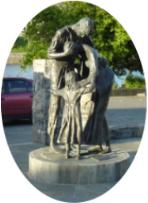Extract from Address Given by Pauline Flanagan at the Unveiling of the Famine Family Sculpture
 “We are here today to remember and venerate the two million Irish men, women and children who perished as a result of the Great Famine of 1845-1850. About one million died of starvation and another million emigrated. Author Thomas Cahill said, “They belong to us, they are of our blood – we have an obligation never to forget them”. This is an important opportunity to re-examine a period that was once cloaked in silence. The Great Hunger nearly eliminated our culture, our language, and as we stand here on Sligo Quay, a century and a half later, we can re-create in our mind’s eye some of the scenes that took place here. During the summer and autumn of 1847, nine vessels carrying over two thousand persons left Sligo for Canada. Emigration from the port of Sligo as higher for its size than from any other port in Ireland.
“We are here today to remember and venerate the two million Irish men, women and children who perished as a result of the Great Famine of 1845-1850. About one million died of starvation and another million emigrated. Author Thomas Cahill said, “They belong to us, they are of our blood – we have an obligation never to forget them”. This is an important opportunity to re-examine a period that was once cloaked in silence. The Great Hunger nearly eliminated our culture, our language, and as we stand here on Sligo Quay, a century and a half later, we can re-create in our mind’s eye some of the scenes that took place here. During the summer and autumn of 1847, nine vessels carrying over two thousand persons left Sligo for Canada. Emigration from the port of Sligo as higher for its size than from any other port in Ireland.
In the twenty years ending in 1851 more than 60,000 emigrants sailed from Sligo and thousands perished in those coffin ships. A sample of the reports for a few of the individual ships: in ’47 “The Larch” carrying 440 passengers had 108 deaths; “The Queen” with 493 passengers had 137 deaths; “The Avon” with 476 passengers had 236 deaths; “The Virginius” with 476 passengers had 267 deaths. W. E. Forster writes of the West: “The survivors were like walking skeletons – the men gaunt and haggard stamped with the livid mark of hunger; the children crying with pain; the women too weak to stand up. When there before, I had seen cows at almost every cabin and sheep and pigs – now, all the sheep are gone, all the cows, all the poultry killed. The very dogs which had barked at me had disappeared – no potatoes, no oats”.
After a partial failure of the potato crop in ’45, there was some hope of an improvement in ’46 but this was not to be. By February ’47 Father Noone of Grange was writing to the Champion: “Sir, from the sympathy you have shown for our suffering and starving people and your indefatigable exertions on their behalf, I feel that no excuse is necessary for furnishing you with the following list of persons who have been victims of the starvation in the past ten days in the parish of Ahamlish:
John Hoy, Silverhill – aged 12
John Doherty, Breahy, aged 64
Frank Finan, aged 64
Pat Mullen, aged 59
John Waters, Mount Edward, aged 18
James Finan, Silverhill – aged 58
John Quinn, Mount Edward, aged 63
Honor Kivlehan, Streedagh, aged 61
James Leyden, Bunduff, aged 66
Ann Kerrigan, Cashelgal, aged 68
John Gillen, Gortnaleck, aged 15
Mary Gillen, sister, aged 13
James Feeney, aged 40
Mary Gilmartin, aged 56
Own Haran and his son both of whom had to be put in one coffin for want of funds.
William Hooks, Grange, aged 50 and for the last month we had fifty other cases of which no mention was made.
Signed, Dominic Noone, RCC”
Failures of the potato crop continued but never again reached the crisis proportion of Black ’47. The fungus which caused the blight was not finally conquered until 1885 when a French botanist came up with a concoction of Bluestone and Lime which inhibited the fungal growth of the potato stalk.
I now dedicate this memorial to the victims of the Famine and to the thousands who emigrated from Sligo during and after the Famine times. May they rest in peace. Requiescant in pace. Ar dheis Dé go raibh anamnacha na marbh”.
Sligo Quay Side, July 27th 1997
Re-printed in programme notes for 150th Anniversary Production of “The Black Stranger” by Gerard Healy, August 1997
Tags: Black Stranger, Great Famine, History







